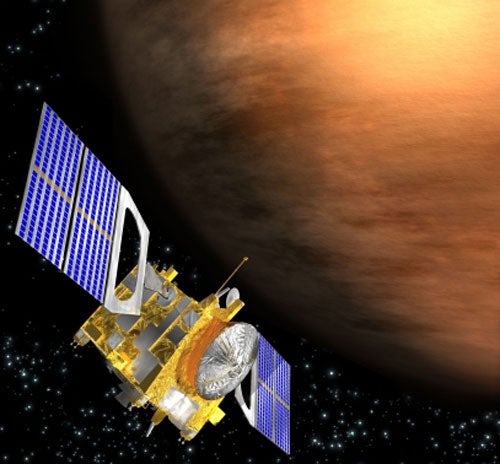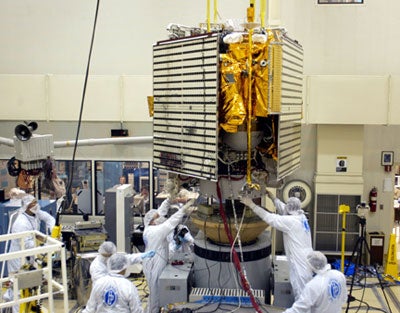The European Space Agency’s (ESA) Venus Express spacecraft reaches its destination in April. The probe will study how Venus’ atmosphere circulates, measure the physics and chemistry of its cloud layer, determine what the lower atmosphere is made of, and map the planet’s surface in the infrared. According to Thomas Thompson, a science manager for U.S. participation in ESA’s Mars Express mission at the Jet Propulsion Laboratory in Pasadena, California, Venus Express is an important “pathfinder” for an eventual sample-return mission.
About 6 months after Venus Express has settled into studies of the cloud-shrouded world, it will be joined briefly by another spacecraft.
MESSENGER to Venus
NASA’s MESSENGER spacecraft (the name’s short for MErcury Surface, Space ENvironment, GEochemistry, and Ranging) is designed to investigate Mercury, not Venus. But to catch its swiftly moving target, MESSENGER will use multiple flybys of Venus and Earth to boost its speed. On December 12, 2005, mission controllers fired the craft’s thrusters for more than 8 minutes, changing MESSENGER’s speed by 706 mph (1,136 km/h). This put the probe on track to fly past Venus at an altitude of 1,951 miles (3,140 kilometers) October 24, 2006.
NASA’s MESSENGER spacecraft (the name’s short for MErcury Surface, Space ENvironment, GEochemistry, and Ranging) is designed to investigate Mercury, not Venus. But to catch its swiftly moving target, MESSENGER will use multiple flybys of Venus and Earth to boost its speed. On December 12, 2005, mission controllers fired the craft’s thrusters for more than 8 minutes, changing MESSENGER’s speed by 706 mph (1,136 km/h). This put the probe on track to fly past Venus at an altitude of 1,951 miles (3,140 kilometers) October 24, 2006.
Engineers prepare the MESSENGER spacecraft for a vibration test at the Johns Hopkins University Applied Physics Laboratory, where the Mercury-bound NASA spacecraft was designed and built. MESSENGER’s mirrored solar panels are folded in on the spacecraft’s sides.
NASA /JHUAPL / Carnegie Institution of Washington
For the next 7 months, mission controllers at Johns Hopkins University’s Applied Physics Laboratory in Laurel, Maryland, will perform routine housekeeping tasks and fine-tune instruments to prepare the craft for its first Venus flyby. The maneuver will occur near the beginning of a 2-week period when the spacecraft is too close to the Sun to allow communications from Earth, so controllers will prepare MESSENGER to fly for an extended period without ground contact.
This will be the first of two Venus flybys. MESSENGER will sweep more than 10 times closer to the planet June 5, 2007. After that comes a series of Mercury flybys (January and October 2008, and September 2009) that will help MESSENGER match its target’s speed. In March 2011, after 15 trips around the Sun and a 4.9-billion-mile (7.9 billion km) trek, MESSENGER’s engine will fire to insert the craft into Mercury orbit.
Venus Climate Orbiter
Planned for launch in 2008, Japan’s Venus Climate Orbiter (VCO) will complement the work of Venus Express. Four cameras will image the planet in wavelengths from infrared to ultraviolet, and a fifth camera will search for lightning. The spacecraft will capture global images of the planet every 2 hours. Moreover, for about 20 hours at the farthest end of VCO’s orbit, the spacecraft’s angular speed matches the atmosphere’s super-rotation at the 31-mile (50 km) level. Mission planners say the spacecraft’s ability to take successive global images will reveal the driving force of Venus’ strange atmosphere.
Planned for launch in 2008, Japan’s Venus Climate Orbiter (VCO) will complement the work of Venus Express. Four cameras will image the planet in wavelengths from infrared to ultraviolet, and a fifth camera will search for lightning. The spacecraft will capture global images of the planet every 2 hours. Moreover, for about 20 hours at the farthest end of VCO’s orbit, the spacecraft’s angular speed matches the atmosphere’s super-rotation at the 31-mile (50 km) level. Mission planners say the spacecraft’s ability to take successive global images will reveal the driving force of Venus’ strange atmosphere.











